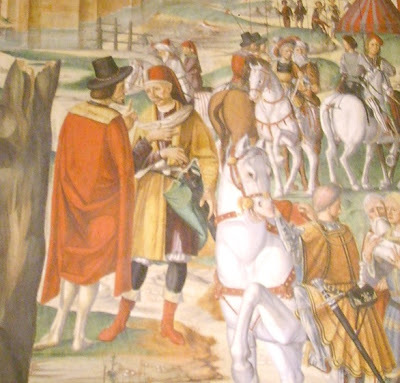By George. E. Georgas, fencing coach, Pammachon Hellenic Martial Art Instructor, and Research Scholar for the Meyer Freifechter Guild.
I thank my student and member of the Academy of Historical European Martial Arts ‘Leontes’, Mr. Aggelos Pilidis for his translation from Greek to English language
In previous articles I have proven with evidence taken both from historical sources and from works of art that, during the Renaissance, the Greek (and Albanian ) Stratioti were serving under European armies, like those of the Most Serene Republic of Venice and the Holy Roman Empire of the German Nation. These poor, strange soldiers were so popular that they ended up having great impact on the martial arts of their employers.

I was also under the suspicion that the Greek mercenaries that were serving the German empire had come in contact with the German fighting guilds and brotherhoods. I first had this thought reading the books of the last Master of Arms that followed the teachings of Liechtenauer. He mentioned that in his travels he had met and trained under some foreign, exotic warriors. I am of course referring to the Master of Arms and Freifechter Joachim Meyer.

I thought my supsicion could be true, since many Greek (Romioi) mercenaries had been knighted. As knights, they had the right to bear a longsword and use it in combat along with the rapier and of course the sabers that were the standard weapon of the Stratioti. Examples of such men are the brothers George and John Manesis.
My second suspicion was about the Freifechters. Long before they were called that, the guild had another name for very short time: Saint George’s Guild. Saint George wasn’t particularely popular among the Germans, but he was an important figure in two kingdoms, those of the English and the Eastern Roman Empire. But the latter was no more.

Despite that, the patron saint of the mercenary Greek (Romioi) Stratioti was St. George, and that was where I started thinking that Greek warriors were in contact with the guild. Of course, the English could have also been in contact with the guild, but there are no mentions of English knights and warriors serving under the German Empire. To the contrary, there were German instructors teaching the enemies of the English, the Scottish. On the other hand there’s a plethora of Greek mercenaries serving under the German Empire.

Of course, the fact that the Stratioti were in contact with or part of the guild was still an unproven hypothesis.
Later the guild changed its name to the Freifechter Guild and its patron saint to St. Vitus, patron saint of scribes and calligraphers, whose symbol is the quill. The quill became the Freifechters’ symbol, and that is why they were also called Federfechters.
They also used to adorn their hats with a quill, to let others know they were part of the guild.


Each guild and brotherhood of that time had a symbol, and that of the mercenary Stratioti was their strange long hats. Indeed, their attire is recorded in Spanish catalogues that describe the clothing of the people of the then known world. Those hats were worn by soldiers, their captains and even those of them that were knighted.




So we come to understand that the Stratioti hat, their strange attire, and the quill in hats of some, were a declaration of their identity. The first were the strange, poor soldiers, and those who wore quills were declaring themselves to be Freifechters or Federfechters and were unique (in their time).


You can imagine my surprise when, in a painting, I noticed something proved my theory, that there Greek (Romioi) mercenaries were members of the Freifechter Guild. The 16th century painting is called Adoration of the Magi, and is located at the Fitzwilliam Museum in Cambridge. In it, one can see a Greek Stratioti in the role of one of the magi. His black hat is adorned by a feather.

But can something like that be proven from a painting?
Of course, if you think about the fact that many of the Freifechters or Federfechters were mysticists, alchemists, some were wizards, others were serving under the Church, others were calligraphers, and in many of their books and paintings contained symbolisms that only insiders could understand. In short, we have a 16th century painting in which the artist was partly inspired by a Greek Stratioti, that was both a Freifechter and a Christian, given his role as one of the three magi.
Bibliography
The Memoirs of Philip de Commines, Lord of Argenton: Containing the Histories of Louis XI and Chales VIII, Kings of France, and of Charles the Bold, Duke of Burgundy, μετ. του Anrew R. Scoble, τόμος 2, εκδ. 1856, σελ. 216.
Der Weiß-Kunig: eine Erzählung von den Thaten Kaiser Maximilian des Ersten, herausgegeben aus dem Manuscripte der kaiserl. königl. Hofbibliothek von Marx Treitzsaurwein auf dessen Angeben zsgetragen, nebst d. von Hannsen Burgmair dazu verfertigten Holzschnitten, Βιέννη 1775.
The Memoirs of Philip de Commines, Lord of Argenton: Containing the Histories of Louis XI and Chales VIII, Kings of France, and of Charles the Bold, Duke of Burgundy, μετ. του Anrew R. Scoble, τόμος 2, σελ. 201, εκδ. 1856.
Ο Meyer, o Giganti, και o Graf και οι Παράξενοι Φτωχοί Στρατιώτες, Του Γεώργιου Ε. Γεωργά
Ποιοι ήταν οι Ελεύθεροι ξιφομάχοι της αναγέννησης; Του Γεώργιου Ε. Γεωργά
Joachim Meyer, Gründtliche Beschreibung der Kunst des Fechtens (1570)
Reblogged this on Ακαδημία Ιστορικών Ευρωπαϊκών Πολεμικών Τεχνών.
LikeLike
[…] E. Georgas, «The poor and strange Greek Stratioti who was member of the Freifechter Guild» (11 Απριλίου 2016). Ελληνική Συντεχνία Ελεύθερων […]
LikeLike